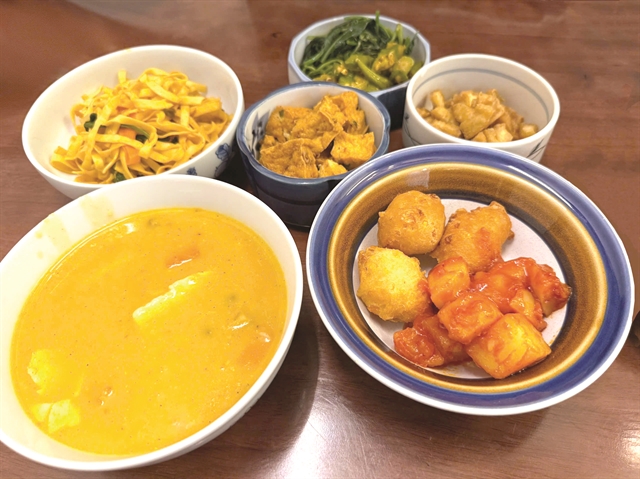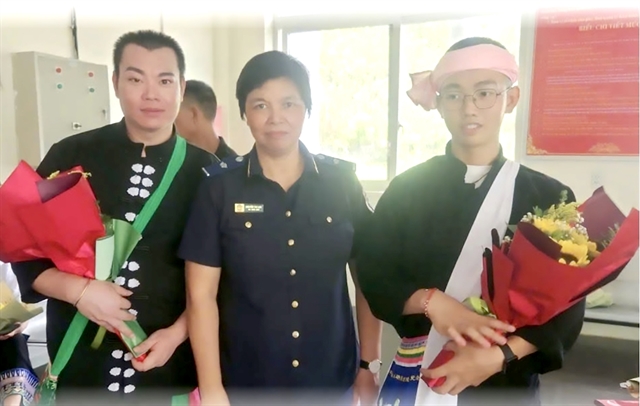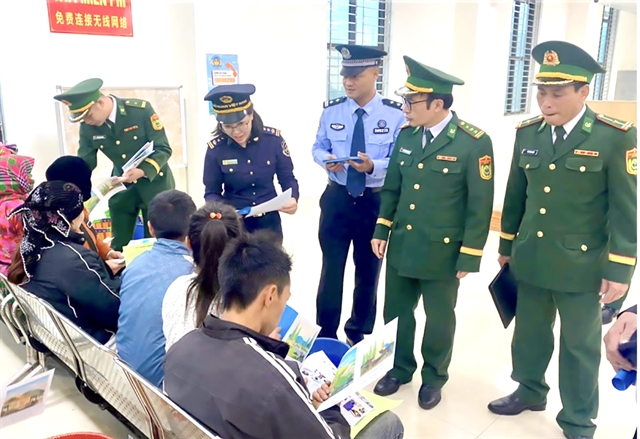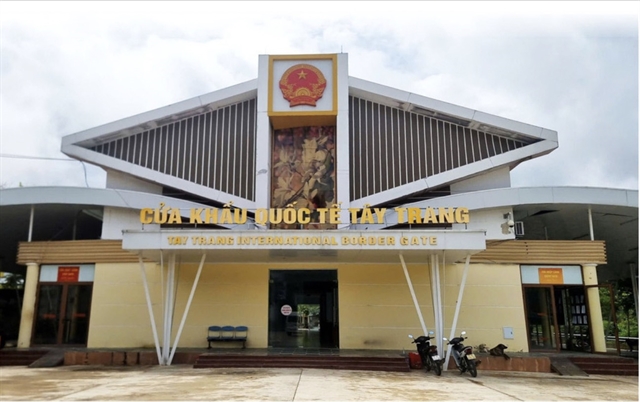 Society
Society

 |
| Nguyễn Thị Lụa (centre) has spent 35 years working at the Ma Lù Thàng border gate in the northern mountainous province of Lai Châu. — Photo tienphong.vn |
LAI CHÂU — At the border gates in northern regions, where winds blow relentlessly and mist curls around the cliffs, shapes wearing green and black can be seen – the colour of the uniforms worn by female customs officers who have devoted their youth to protecting the border, standing resilient in the face of danger and sacrifice to safeguard the flow of trade.
Unlike the police and other border guard forces, which have almost no female officers patrolling the border, female customs officers known as 'roses' are a distinctive feature in border areas.
Born in Ninh Bình Province to a poor family, Nguyễn Thị Lụa was recruited at age 20 as a clerk at the Customs Office in the northern mountainous province of Lai Châu, in the early days of the office's establishment in 1989.
Three years later, she was assigned to Ma Lù Thàng border gate – at the time, the most treacherous border area of Lai Châu, neighbouring China.
“The road from Lai Châu Town to Ma Lù Thàng was winding and bumpy, with many sections still scattered with mines left from the border war,” Lụa told Tiền Phong (the Vanguards) newspaper.
“Once, I was sitting on a truck carrying bananas when suddenly a mine exploded behind us, shaking the whole vehicle. That explosion still haunts me to this day,” she said.
At the Ma Lù Thàng border gate, there were only five or six officers, and she was the only woman.
"In the early days, we all lived together in one house. In winter, the wind howled through the cracks, while in summer, the heat was suffocating," Lụa recalled.
“Water for daily use had to be carried from the stream. We grew our own vegetables and raised chickens and pigs. The daily meals were simple, but kept everyone close,” she said.
Her job at the border gate was to check and supervise import-export goods. This often put her face to face with aggressive traders.
Once, after discovering a shipment of medicine containing narcotics, she wrote it up. The trader grew furious, cursed and even lay in wait outside to attack her. Luckily, border guards intervened in time.
“Of course, I was scared, but if I gave in, discipline would no longer be strict,” she said.
If the climate at the border is harsh, the homesickness of those living far from home can be even harsher.
Lụa’s home town was hundreds of kilometres away, so sometimes half a year or nearly a year would pass before she could visit her family.
Before mobile phones existed, even calling her mother was difficult. Lụa had to ride more than 60km to the district centre to reach a post office.
“Usually every two or three weeks, I would go to the district centre to make a call. Hearing my mother’s voice over the phone made me sob uncontrollably,” she recalled.
Lụa is the youngest of five siblings. Her father passed away at a young age, so her mother always hoped she would settle down. Yet, while her peers were getting married, she chose to remain at the border, devoting herself to customs.
Her mother urged her to start a family many times, but after years without a result, she stopped saying anything. “Sometimes I also feel sad, but I think that as long as I can work and contribute to keeping peace at the border, that is enough,” Lụa said.
After nearly 20 years at Ma Lù Thàng, in 2011 she was transferred to the Lóng Sập Border Gate in Sơn La Province, where she continued inspection work for six years.
If Ma Lù Thàng was burning hot, then Lóng Sập was piercingly cold.
Many winter nights, the temperature dropped to one or two degrees Celsius, and the cold often made her sick. But she never thought of asking for an easier post.
After more than 35 years devoted to customs at the most difficult border posts, Lụa has witnessed remarkable changes in the northwest region.
Now, with just over a year of service left, she plans to return to her home town in Ninh Bình Province, ending a journey that has spanned nearly her entire life.
“My youth was given to the border, with many unforgettable memories. My only regret is that two years ago, my mother passed away before I could return,” she said.
Unlike Lụa, earlier this year 38-year-old Điện Biên Province customs officer Trần Thị Kim Duyên had to pack her bags and left Điện Biên Phủ for the Tây Trang Border Gate, after a restructuring of the administrative apparatus.
She went from a staff office in the city to being in charge of information technology and statistics at the border. The job was familiar, but the environment was different, forcing her to adapt.
Her work is no longer just numbers and reports, but also long days battling homesickness for her child and family.
“At home, my child is still in primary school, so my husband now shoulders all the care and school runs. I can only return home every two weeks or so. Hearing my child’s voice over the phone makes me ache, but since I chose this job, I must try,” Duyên said.
 |
| Customs officers provide local residents with information about smuggling in border areas. — Photo tienphong.vn |
The Tây Trang Border Gate now has about 20 officers, including four women. Their work is not limited to scanning and checking goods, but also often involves confronting increasingly sophisticated smuggling attempts.
“This area lies in deep forest on the Việt Nam–Laos border, far from residential areas, so most of the time officers spend the entire day working on site. Sometimes ambulances from Laos arrive in Điện Biên Phủ at midnight, and we still have to get up to process paperwork and check goods,” the officer said.
The greatest difficulty at Tây Trang is water. To get water, officers must channel it from mountain streams. In summer it dries up, but in the rainy season, it becomes muddy.
“At first, many female officers, unfamiliar with the water and weather, suffered from rashes and itching,” she said.
If the Tây Trang winds are harsh, then Săm Pun in Tuyên Quang Province – the northernmost border gate into China – is likened to a 'kingdom of fog'. In winter, the cold cuts to the bone, and in summer, temperatures barely exceed 20 degrees Celsius.
Earlier this year, Lương Thị Kim Duyên, head of professional operations at Hà Giang’s Customs Office, volunteered to direct operations at the Săm Pun Border Gate.
Instead of sitting in an office, she now directly commands officers, supervises goods and works with border guards on patrols and educating locals about smuggling prevention, building a friendlier image of customs officials.
“Many locals here cannot speak Vietnamese fluently, and the habit of carrying goods across the border still exists,” Duyên said.
“Once, some people carried pork of unknown origin across. Customs officers confiscated it due to the risk of spreading African swine fever. The residents wept bitterly at losing their meat,” she said.
At Săm Pun, there are four female officers, including Duyên – all married women.
From Hà Giang, they travel up the mountains, carrying everyday worries of young children, elderly parents and husbands to work.
Yet, once in uniform, they stand strong like border soldiers.
“Male colleagues are free after their shifts, but for us, work continues: calling children to remind them to study, asking husbands to take care of school runs, worrying about parents’ illnesses,” Duyên said.
Nguyễn Thùy Dương is another female customs officer stationed on the northwest border. She is the only woman at the Lóng Sập Border Gate in Sơn La Province, one of the hottest spots for drug smuggling along the Việt Nam–Laos border.
Before Lóng Sập, Dương spent four years at Tây Trang and some time with the Anti-Drug Control Team at Điện Biên Customs.
While working at Tây Trang, she sometimes visited her parents in Điện Biên Phủ. But since she moved to Lóng Sập, the 300km of steep, winding roads have made every trip home a gruelling ordeal.
“Going home takes an entire day. I can only manage once every month or two. My parents are now old and weak, and we only speak by phone – but even the mobile signal here is unstable, so homesickness is constant,” Dương said.
The climate at Lóng Sập is erratic. In winter, the cold cuts to the bone. In summer, people still wear thick jackets.
“Here, most people are ethnic minorities, so life is very quiet. For shopping or other needs, we must ask acquaintances to send things from Mộc Châu Town,” she said.
At Lóng Sập, Tây Trang or Săm Pun, all far from residential areas with only one market per week, fresh vegetables and food are scarce. Outside working hours, customs officers dig soil, grow vegetables and raise fish.
This self-sufficiency – once a military habit – has become a solution for customs officers’ meals.
After dedicating all her time to work, now over 40, Dương is still single.
“My parents always hope, but with the nature of border work, once I chose this uniform, I had to accept sacrifices. Here, one cannot survive without resilience. As long as trade flows smoothly and sovereignty is safeguarded, I feel comforted,” she said.
At Ma Lù Thàng, Tây Trang, Lóng Sập or Săm Pun, female customs officers continue to overcome hardship every day and fulfil their dual roles – not only as officers but also as mothers, wives and daughters far from home. — VNS
 |
| Tây Trang International Border Gate in Điện Biên Province on the Laos frontier. Photo tienphong.vn |